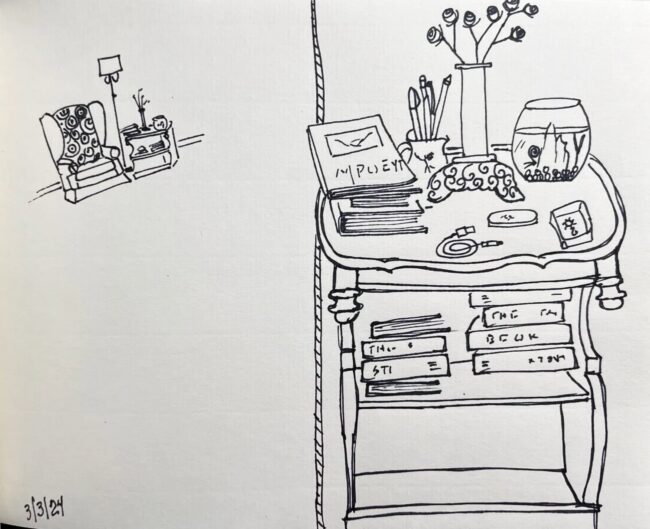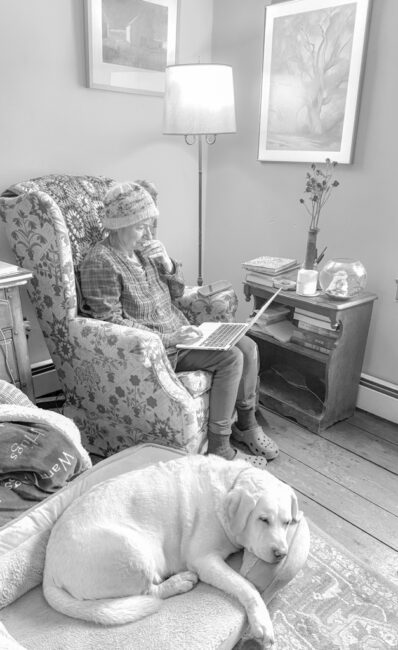Maria is not nearly as combative or argumentative as I am, but she seemed to have joined in the Amherst College flap about suggesting a photograph of mine was a still life rather than a portrait.
The academics freaked out and called me all kinds of names, including being Trumpist and ignorant (are these different things?) Whenever Maria goes with me to a hospital visit or a doctor’s appointment, she loves to sketch.
(Photo: Maria going out to lunch and saying goodbye.)
She sketches in notebooks and shows them to me, but only to me. She keeps them in notebooks. Yesterday, she put a lovely sketch she did and labeled it a still life.
I warned her that the head of the Amherst College art department had a fit over my ruminations; she said what I wrote was wrong and not debatable. She might disagree with Maria’s label.
I would accomplish nothing, said the professor, but appearing ignorant. She doesn’t know that this has happened before.
One of her students suggested I was helping climate change deniers and Trumpism. It was social media at its most vigorous and useless.
Several animal rights trolls took advantage of the moment to jump in and say I was also a cat criminal because Zip, our exotic barn cat, doesn’t sleep inside at night.
Maria surprised me by posting her sketch and clearly labeling it a “self portrait.”Maria is an artist and has a master’s degree in sculpture. She knows her stuff. She even sketched her beloved snails in their bowl.
The self portrait is a work of art that the artist, creates about themselves..
She is not as difficult as I am, and I think she nailed it on the head.
Maria said her sketch was a self portrait because it reflected her life, the corner of the hours where she reads, blogs, and sometimes meditates.
(The Blogger, Jon Katz)
I like the sketch, and I like the definition. Like me, she likes to draw her conclusions about here art. She is a lot nicer than I am. And a good deal more talented.
She has no time at all for social media foolishness.
I took another “blogger” photo for my collection. It doesn’t look like a portrait or a still-life painting. It just looks like Maria blogging.
I love this series, including Zinnia napping at her feet.




I apologize in advance for the length of this comment!
Another point in this amusing discussion is that one of the things art does is put things into new categories. To academics working on classifying things, a can of soup was simply a utilitarian “product” until Warhol said, in effect, no, this is “art.” Poems famously put new meanings into words and phrases. “Shall I compare thee to a summer’s day” supposes that two completely different things — thee, and a day — nevertheless have something in common; they’re in the same category. Ella Wilcox’ poem The Speech of Silence begins with the idea that silence can be a sea that a ship could sail across. The entire field of photography was “obviously” NOT ART — but now it is, just as obviously.
I work with ontologies and taxonomies, and these things are at some level completely arbitrary, and they exist to be used in particular ways, usually by people who need to delve deeply into a specialty. It’s useful for a linguist, for example, to know a great deal about word placement and sequence, and how in some languages a double negative means MORE negative, while in others it’s just confusing and people argue that a double negative becomes a positive. To make their taxonomy easier to cope with, linguists (like so many other specialists) use words that anybody else CAN use, but generally don’t bother. Here are two of those words: “antepenultimate” and “preantepenultimate.” (Those mean the third and fourth words from the end, such as in a sentence.) They’re perfectly good words, but outside a particular specialty they’re not needed, any more than a photographer needs to calibrate a monitor if they don’t have a need to match colors on two different devices or systems.
Outside of rigorous technical specializations (and I mean “technical” in a very loose sense) categories are supposed to be flexible and slippery; that’s where a lot of creativity comes from. Maria’s Meditation Tree artworks, for one, introduce the ideas of “tree” and “meditation” and “depth” in a purely visual way. A strict realist art critic could probably complain that “trees don’t really look like that.” The idea of strict, inflexible categorization is pretty well known, and it’s often the source of humor. There was a pretty amusing advertising campaign years ago for Reese’s Peanut Butter Cups that poked fun at resistance to the idea of pairing chocolate and peanut butter.
I guess my main point is just this: one of your grouchy commenters said, at one point “words have meanings.” But words do NOT have meanings. They’re just symbols we agree on; the meaning is in people. When people need strict precision, it’s for a particular purpose, and otherwise, our minds are flexible. If we weren’t that way, there wouldn’t be any art at all.
Fascinating comment. It’s given me lots to think about. Thanks!
This is one of the most thoughtful and interesting posts I can recall seeing in my many years online. Thanks for it Pete, you took a complicated issue and made real sense. This is what my blog comments were meant for, not angry people venting their venom. Thanks.
Definitely a thought-provoking response, Pete. Thanks for expanding my mind, and my vocabulary.